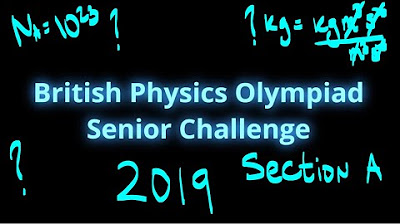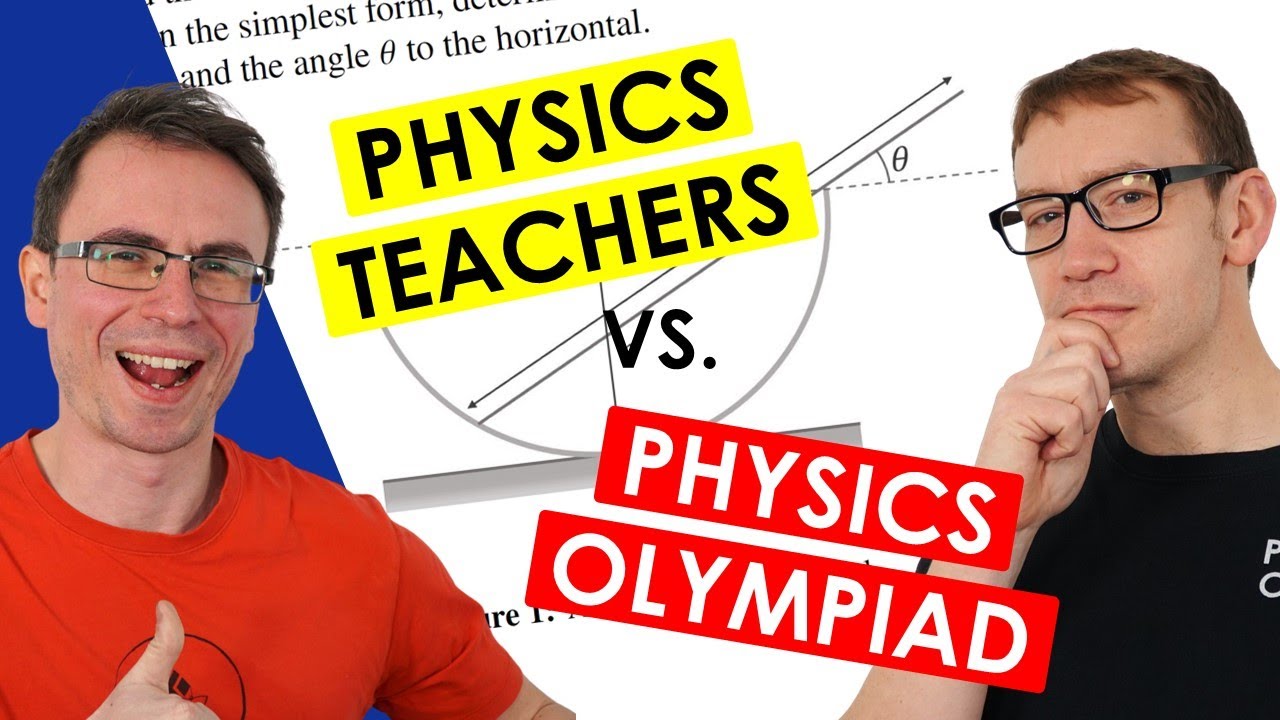My Solutions to the British Physics Olympiad: BPhO Senior Challenge 2018 Multiple Choice
TLDRIn this educational video, the host tackles multiple-choice questions from the 2018 British Physics Olympiad Senior Challenge. Starting with an estimation of a page's thickness, the host explains the process of elimination and the importance of unit consistency in equations. The video covers topics like electrical resistance, dimensional correctness in equations, and the physics of a finger's impact on a beaker's balance. It's an engaging walkthrough aimed at sparking interest in physics problem-solving.
Takeaways
- 📝 The video discusses multiple choice questions from the 2018 British Physics Olympiad Senior Challenge.
- 🔍 The first question is an estimation problem about the thickness of a page, suggesting it's about 0.1 millimeters.
- ⚡ The second question explains the unit of electrical resistance in terms of base units, deriving it from the formula for voltage.
- 🔋 A volt is defined as a joule per coulomb, and the video breaks down the units of a joule into kg m²/s².
- ⚖️ The third question is about choosing the correct formula for the speed of an astronomical object, emphasizing the importance of dimensional correctness.
- 🌌 The fourth question is an estimation of the number of atoms in a grain of sand, with the correct answer being approximately 10^20 atoms.
- 🧠 A useful fact mentioned is that the number of electrons in the human body is about 10^28.
- 💧 The final question involves a physics concept where a student's finger in water causes an increase in the balance reading due to Newton's third law.
- 📚 The video aims to be helpful for those preparing for the British Physics Olympiad and encourages viewers to subscribe for more content.
- 🤓 The presenter uses clear examples and explanations to help viewers understand the concepts behind the physics questions.
Q & A
What is the main topic of the video?
-The main topic of the video is to discuss and solve multiple choice questions from the British Physics Olympiad Senior Challenge from 2018.
Why can't the thickness of a page in an exam paper be one millimeter?
-The thickness of a page can't be one millimeter because it would be easily measurable with a ruler, and a page is typically about a tenth of a millimeter in thickness.
What is the unit of electrical resistance in terms of base units?
-The unit of electrical resistance, the ohm, in terms of base units is equivalent to a joule per coulomb.
What is the formula for energy that the video uses to explain the unit of a joule?
-The video uses the formula E = 1/2 mv^2 to explain the unit of a joule, which is kg m^2/s^2.
What is the unit of charge, and why is it an ampere-second?
-The unit of charge is the coulomb, which is an ampere-second because charge (Q) is equal to current (I) times time (t), so Q = It.
How does the video explain the dimensional correctness of an equation?
-The video explains that for an equation to be dimensionally correct, the units on the left must match the units on the right. It uses the example of calculating the speed of an astronomical object.
Why is option D the correct choice for the speed of an astronomical object problem?
-Option D is correct because it is the only option that results in units of meters per second, which is the unit for speed, by canceling out the kilograms and leaving the units of c^2/(at).
What is the approximate number of atoms in a typical coarse grain of sand found on a beach?
-The approximate number of atoms in a grain of sand is 10^20.
How does the video relate the number of atoms in a grain of sand to the human body?
-The video states that the number of electrons in a human body is about 10^28, which is a much larger number than the number of atoms in a grain of sand.
What happens to the reading on a top pan balance when a student sticks his finger in the water?
-The reading on the balance will increase due to the up thrust acting on the student's finger, as explained by Newton's third law.
Outlines
📚 Estimation and Units in Physics Problems
The first paragraph introduces a video on solving the British Physics Olympiad Senior Challenge from 2018. It begins with an estimation question about the thickness of a page, suggesting it's about 0.1 millimeters. The presenter then explains the unit of electrical resistance, Ohm, in terms of base units, deriving it from the formula for voltage and current, and relating it to the Joule, the unit of energy. The summary also touches on the correct approach to a problem involving the speed of an astronomical object, emphasizing the importance of dimensional analysis in equations.
🔍 Dimensional Analysis and Estimation in Physics
The second paragraph continues the discussion on physics problem-solving with a focus on dimensional analysis. It discusses the incorrectness of certain answers to a question about the speed of an astronomical object due to incorrect units. The presenter explains why answer D is correct by showing how the units cancel out to result in meters per second, which is the unit for speed. The paragraph also includes an estimation of the number of atoms in a grain of sand, suggesting it's approximately 10^20, and touches on the concept of Newton's third law in the context of a balance with a beaker of water and a student's finger, explaining how the balance reading would increase due to the upward thrust of the water.
Mindmap
Keywords
💡British Physics Olympiad Senior Challenge
💡Estimation
💡Millimeter
💡Volt
💡Joule
💡Coulomb
💡Dimensional Analysis
💡Equation
💡Newton's Third Law
💡Balance
💡Astronomical Object
💡Units
Highlights
Introduction to the British Physics Olympiad Senior Challenge from 2018.
Estimation of the thickness of a page in an exam paper, suggesting it's about a tenth of a millimeter.
Explanation of why the thickness of a page cannot be one millimeter or 10 millimeters.
Discussion on the unit of electrical resistance, Ohm, in terms of base units.
Derivation of the unit of a volt as joule per coulomb.
Conversion of joule into base units using the formula for kinetic energy.
Explanation of the unit of coulomb as an ampere second.
Solving a problem involving the speed of an astronomical object with dimensional analysis.
Dimensional correctness of equations and how it applies to the problem at hand.
Elimination of incorrect answers based on unit mismatch in the equation.
Selection of the correct answer using dimensional analysis for the speed of an astronomical object.
Estimation of the number of atoms in a grain of sand, suggesting it's approximately 10^20.
Comparison of the number of atoms in a grain of sand to the number of electrons in the human body.
Discussion on the effect of a student's finger on the balance when placed in a beaker of water.
Explanation of Newton's third law in the context of the balance and the water's reaction to the finger.
Illustration of how the balance reading increases due to the interaction between the water and the finger.
Conclusion and invitation to subscribe for more solutions to the British Physics Olympiad.
Transcripts
Browse More Related Video

Unofficial Physics Olympiad Answers - 2023 BPhO Senior Physics Challenge

My Solutions to the British Physics Olympiad, BPhO Senior Challenge 2019 Multiple Choice

A Level Physics Teachers Take On Olympiad Questions

Can't solve? Try dimensional analysis! British Physics Olympiad, BpHo Solution

Tips and overview of Round 1 of the British Physics Olympiad

My Solutions: British Physics Olympiad Round 1 2020 - Section 1 a to c
5.0 / 5 (0 votes)
Thanks for rating: